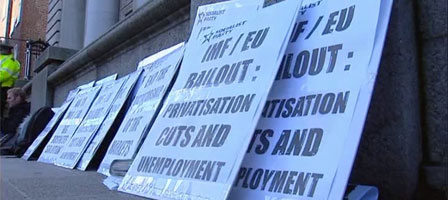Currently investment markets are experiencing a “phoney war,” the words used to describe the quiescent period in 1940 before the Germans came smashing into France to destroy one of Europe’s greatest armies in a matter of days.
The stockmarket that most people still believe leads the world, Wall Street, continues in its strong uptrend, seemingly signalling coming greater strength in the US economy. But historical evidence is that such signals often prove to be false.
Can the US economy really withstand fading fiscal stimulus, the adverse impact on spending of the worsening crisis in state and city finances, the still-worsening situation in real estate (both residential and commercial), and the persistently negative impact of high unemployment?
Faced with huge financial commitments (the unfunded pension liabilities of municipalities and states have reached 2½ times their tax base), sharply reduced revenue from property taxes, and less help from the federal government (the states will receive about $38 billion less in aid in the new fiscal year starting July 1), it may be politically impossible for public authorities to raise tax rates or cut services such as policing sufficiently to balance their books.
“A few big cities,” the FT comments, could decide that “the wrath of bondholders is less scary than that of voters.” Could default by US cities on their bonds be one of the big financial shocks of 2011?
American home prices continue to decline, and many analysts expect further falls averaging 10 to 20 per cent over the next couple of years. The crisis has already destroyed $9 trillion of owners’ equity investments in their homes and roughly a quarter of all home mortgages are now “under water” – outstanding loan liabilities are greater than the home values.
“The continuing decline in the housing market is a dagger pointed at the heart of an incipient economic recovery,” comments Mort Zuckerman, chairman of Boston Properties.
In commercial real estate, the situation is even worse. Half of all mortgages are “under water.” Banks are only managing to avoid acknowledging a huge amount of bad debt by extending loans to the sector, delaying their repayment. Over the next four years $1½ trillion in such loans will fall due for repayment. Refinancing them will be both difficult and expensive for borrowers.
The official unemployment figure is down a bit at 9.4 per cent. But only because many people have stopped looking for work, so are no longer included in the national statistic. Experts reckon the true figure for the out-of-work is more like 17 per cent, and nowhere near enough new jobs are being created to match annual growth in the work-force.
The mega-banks are back into profit only because of virtually unlimited, nearly-free financing by the Federal Reserve and explicit or implicit government guarantees, while hundreds of smaller banks suffer from competition with the unfairly privileged big fellers and state mortgage agencies, as well as from their greater exposure to property sector bad debt.
Corporate profits continue to grow, helped by current economic recovery, unusually low interest rates, caution about investing in expansion, tight control on costs focused on refusal to employ many more workers or raise pay, and earnings from abroad. Foreign operations now account for about one third of the earnings of American companies.
But for how much longer can this continue?
The dollar has been weakening a little recently, but I reckon it will soon resume its medium-term uptrend, perhaps strengthening from the current area of 1.33 to the euro to 1.18 as problems in Europe trigger another bout of pessimism.
The other major currency that now looks a buy is the Ozzie dollar, due to bounce back from the negative impact of the floods. I am impressed by the way the Australians, personally and governmentally, appear to be handling the catastrophe. Yet another confirmation that their nation is an attractive long-term investment for global portfolios.
CopyRight – OnTarget January 2011 by Martin Spring






